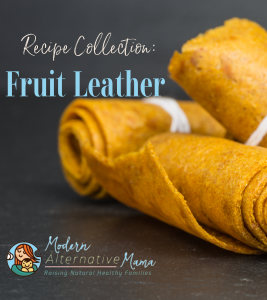The summer’s bounty is overflowing right now. This is the best time of year! The summer goodies are still pouring out of gardens — peaches, tomatoes, cucumbers, squash, peppers, etc. — yet the fall goodies are beginning to come as well (pears, apples, grapes, potatoes, garlic). It’s just a wonderful time of year for fresh foods.
It’s also a time for working hard — to preserve that harvest to enjoy all year long! I’ve recently begun my massive tomato canning (200 lbs. down so far, which is about 58 jars of sauce), and I’ve also been doing fruit leather! We love peaches, but mostly to eat fresh or toss into smoothies. The canned peaches haven’t been that popular for us the last couple of years. But the fruit leather…the kids love it!
A small strip of real fruit leather at a health food store will run $0.50 – $0.75! That’s not cheap for that little snack. I made 104 roughly 4×6 sheets of fruit leather for just $12. That is really cheap and awesome!
Luckily fruit leather is also super simple. You can really use any fruit you want, but if you choose a less-sweet variety (berries, peaches), pair it with a sweeter variety (apples, pears, bananas) in order to naturally increase the sweetness and improve the flavor. I chose peaches and pears for mine, although I’ve also done peaches and apples. I really choose whatever I can find at the farmer’s market that is “seconds” and cheap.
Also, a friend gave me a tip to coat apple peels in cinnamon and dehydrate those as well, like ‘apple chips.’ Thanks Michelle! My kids loved those and something that would have been trash is now a snack.
Fruit Leather
Ingredients:
- 4 lbs. peaches (or strawberries, blueberries, etc.)
- 1 lb. pears (or apples)
OR
- 5 lbs. of apples, pears, other sweeter fruit
Directions:
Slice your peaches (or other fruit). Place fruit into a large pot.
Add water to the bottom — just a small amount, 1/4 c. or so. Then, put the pot on the stove and put a lid on it, and let it steam on low for 30 minutes or so.
When the fruit is soft, scoop it out into a blender.
You will have liquid left in the bottom. I strained it and heated it up separately, mixed it with gelatin, and made jell-o out of it. You can drink it, use it to sweeten smoothies or baked goods, or get rid of it. Whatever you want.
Puree the fruit.
If it is pretty thick, like applesauce, you can pour it straight onto parchment paper on dehydrator trays or baking sheets (use the parchment paper!). If it’s thinner, pour it back into the pot.
Simmer on low until it’s thick enough. I’ve done it with and without this step and it always worked. You don’t want it too thin though.
Pour onto dehydrator sheets, about 1.5 – 2 c. per large tray. You want a nice layer, but not too thick.
Put into the dehydrator on 120, or into an oven on low (170). It takes a good 12 – 15 hours in a dehydrator; an oven would only take 2 – 3, so watch carefully.
Pull it out and you’re done! Fruit leather. I cut mine into about 9 – 10 pieces per large sheet and stored them in a bag.








I love this idea, but how do you keep it from sticking to the paper? have tried it twice. Once with wax paper and once with more expensive parchment paper coated with a little coconut oil. Both times it stuck like glue and all that fruit was completely wasted. 🙁
The puree may need to be thicker. I tried it with a thinner puree before and had it stick like that.
How long does the fruit leather keep, and does it need to be refrigerated? I look forward to trying my hand at making this! Thanks!!
Should keep for several months and it doesn’t need refrigeration. 🙂